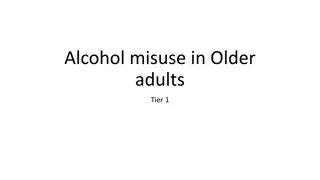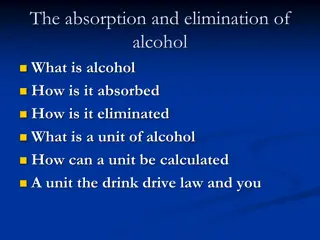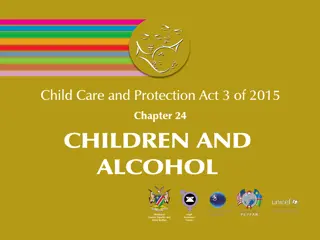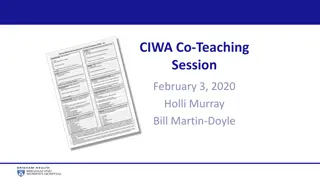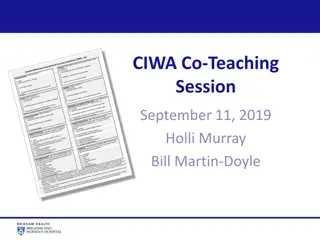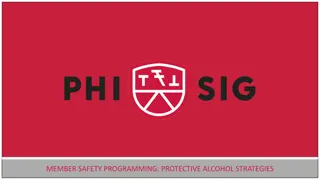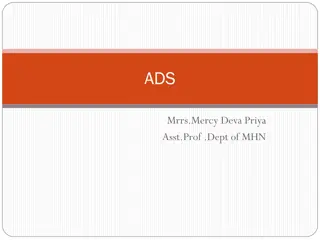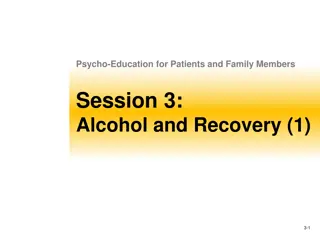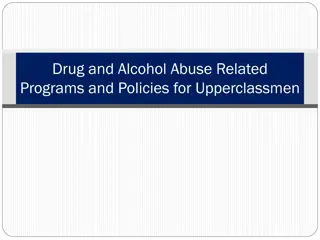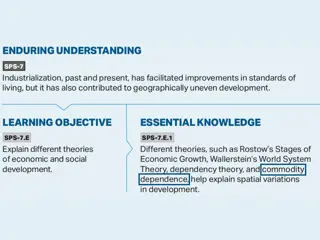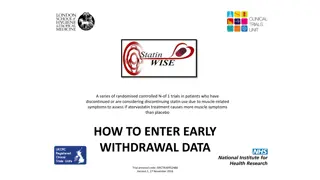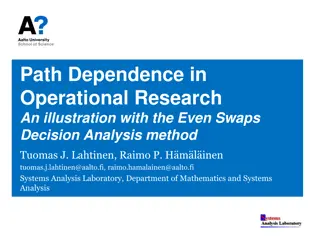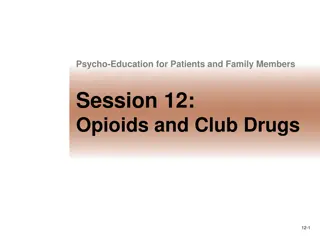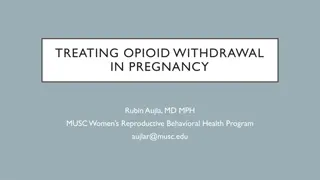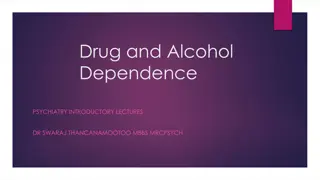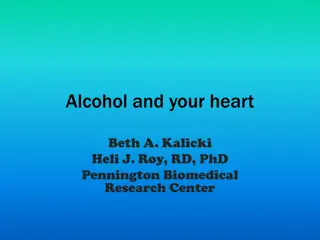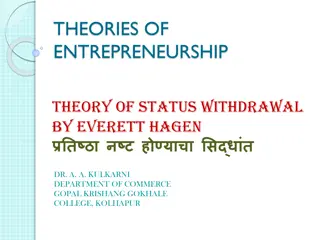Understanding Alcohol Dependence, Withdrawal, and Health Impacts
Alcohol dependence is a serious issue leading to many deaths and health problems. Dr. Joanne Woolley highlights the impact of alcohol on mortality rates, family breakdowns, job loss, and societal costs. Guidelines for safe alcohol consumption and calculations for unit intake are provided. Recognizing signs of alcohol dependence, such as compulsion to drink and withdrawal symptoms, is crucial for early intervention and prevention.
Download Presentation

Please find below an Image/Link to download the presentation.
The content on the website is provided AS IS for your information and personal use only. It may not be sold, licensed, or shared on other websites without obtaining consent from the author. Download presentation by click this link. If you encounter any issues during the download, it is possible that the publisher has removed the file from their server.
E N D
Presentation Transcript
ALCOHOL: DEPENDENCE, WITHDRAWAL AND OTHER ISSUES Dr Joanne Woolley
WHY IS IT RELEVANT? In 2017, a total of 7,697 deaths in the UK were caused directly by alcohol Alcohol specific deaths in women hit the highest levels on record in 2017, at 8 deaths per 100,000. With that said, the statistics show men remain twice as likely to have a directly alcohol related cause of death. If including deaths related to alcohol consumption, the figure is much higher and could be up to 1 in 20 deaths being attributable to alcohol consumption1
WHY IS IT RELEVANT? Alcohol as a cause of ill health & mortality Men aged 16-24: 25% of deaths attributable to alcohol Women aged 16-24: 14% of deaths attributable to alcohol Cause of family breakdown, loss of job, domestic violence and other crimes Huge cost to economy and NHS including hospital admissions- estimated 337,000 admissions directly related to alcohol, ~2% of total. 2
HOW MUCH? 14 units per week for men and women; spread across minimum of 3 days with alcohol free days throughout the week.
HOW MANY UNITS IN ? 1 pint of Guiness?
HOW MANY UNITS IN ? Double measure Gordons Pink Gin and tonic?
UNIT CALCULATIONS (Total volume of drink mls x ABV)/1000 E.g A pint (568mls) of strong lager at 5.2% ABV works out as 568 (mls) x 5.2 (%) / 1000 = 2.95 units.
ALCOHOL DEPENDENCE
ALCOHOL DEPENDENCE A compulsive need for and use of alcohol characterized by tolerance and well-defined physiological symptoms upon withdrawal. A persistent use of a substance known by the user to be harmful, with impact on physical, psychological, social and financial wellbeing. ICD10 features of alcohol dependence: - Compulsion to drink, with loss of control - Withdrawal symptoms - Persistence despite evidence to suggest harm - Neglect of normal activity due to drinking - Increasing amounts needed to establish effect (tolerance)
ASSESSING LIKELIHOOD OF DEPENDENCE- CAGE SCREENING QUESTIONNAIRE C- have you ever felt you need to cut down on your drinking? A- have you ever become annoyed at people criticizing your drinking? G- do you ever feel guilt about your alcohol intake? E- have you ever felt you need an Eye-opener/early morning drink to steady your nerves/hangover?
ASSESSING LIKELIHOOD OF DEPENDENCE- AUDIT QUESTIONNAIRE AUDIT-C: questions 1-3. If score >5, to continue to complete assessment. AUDIT: Score 0-7: Low risk Score 8-15: Moderate risk Score 16-19: High Risk Score >20: Likely dependence, referral to alcohol services
SADQ SCORE- ASSESSING SEVERITY OF DEPENDENCE The SADQ questions cover the following aspects of dependency syndrome: physical withdrawal symptoms affective withdrawal symptoms relief drinking frequency of alcohol consumption speed of onset of withdrawal symptoms Answers to each question are rated on a four-point scale: Almost never 0 Sometimes 1 Often 2 Nearly always 3 A score of 31 or higher indicates "severe alcohol dependence". A score of 16 -30 indicates "moderate dependence A score of below 16 usually indicates only a mild physical dependency. A chlordiazepoxide detoxification regime is usually indicated for someone who scores 16 or over.
PHYSICAL SIGNS OF ALCOHOL WITHDRAWAL 8-10 hours after last drink: Anxiety, insomnia, nausea and abdominal pain. 24-48 hours after last drink: High BP, sweating, febrile and confusion. 48 -72 hours after the last drink: hallucinations, fever, seizures.
DELIRIUM TREMENS Delirium tremens: Up to 5% of alcoholic withdrawals. Occurs day 3-5. Severe confusion, auditory, visual and tactile hallucinations with complete loss of reality, seizures and sweating. Up to 40% mortality rate without treatment. Acute treatment is with a benzodiazepine; NICE 1st line is lorazepam.
CIWAR SCORE- SEVERITY OF PHYSICAL WITHDRAWAL SYMPTOMS The CIWAR score is used to assess which patients need regular withdrawal medications, and can be helpful for healthcare staff to decide when further PRN doses of medications may be needed. Early intervention for CIWAR score >8 leads to better outcomes for withdrawal. Stat/PRN doses of medication should be administered for CIWAR 10-15.
Chlordiazepoxide (Librium) First line benzodiazepine recommended for withdrawal. It has a long half life, and is less likely to be used as a drug of abuse compared to diazepam. Withdrawal regimens are based on the level of alcohol dependence/units consumed. A typical withdrawal regimen lasts 7-10 days depending on patients CIWAR score throughout Although chlordiazepoxide having a long half life is useful for smoother withdrawal, it can cause over-sedation in patients with advanced liver cirrhosis. In patients with liver cirrhosis or acute liver injury, lorazepam is felt to be safer MANAGEMENT OF ALCOHOL WITHDRAWAL Alcohol withdrawal is managed with benzodiazepines. 1st line- chlordiazepoxide 2nd line (for patients with liver failure who cannot have chlordiazepoxide)- lorazepam
WITHDRAWAL- THE SCIENCE BIT GABA is the major inhibitory neurotransmitter in the brain- chronic alcohol misuse causes remodelling and insensitivity to GABA. When alcohol is suddenly withdrawn, GABA levels and thus inhibition falls and causes overstimulation of the CNS. Benzodiazepines exert their effect by stimulating GABA to receptor binding, causing a decrease in neuronal activity and relative sedation.
COMMUNITY INTERVENTIONS FOR PATIENTS WHO ARE NOT ACUTELY WITHDRAWING Brief Intervention Provide a frank discussion regarding harmful drinking, discussion of techniques to cut down, and written information for support groups/websites. Use motivational interview techniques, and ensure follow up appointment is booked. NICE recommends:3 Referral for CBT, couples therapy or family therapy is also recommended. www.actiononaddiction.org.uk www.alcoholconcern.org.uk www.downyourdrink.org.uk
COMMUNITY INTERVENTIONS FOR PATIENTS WHO ARE NOT ACUTELY WITHDRAWING Pharmacological management 1. Thiamine and Vitamin B: often deplete in alcoholics. Prophylactic use can help prevent Wernicke's. 2. Nalmefene is an opioid antagonist and is first line for supporting alcohol abstinence in patients who are not actively withdrawing, alongside psychological support. Naltrexone (another opioid antagonist) and acamprosate (disulphram) are second line alternatives. All should be used in conjunction with psychological support and regular monitoring. If a patient continues to drink alcohol after 6-8 weeks, the medication should be stopped.
SUBSEQUENT ISSUES: WERNICKES ENCEPHALOPATHY AND KORSAKOFF SYNDROME
Wernickes-Korsakoff syndrome is a spectrum of disease related to chronic thiamine deficiency usually related to alcohol use. WERNICKE S-KORSAKOFF SYNDROME Initially described in 1881 by German neurologist Karl Wernicke.
WERNICKES ENCEPHALOPATHY Acute neuropsychiatric disorder due to initially reversible exhaustion of vitamin B stores. It is a thiamine deficiency disorder. Classically seen in alcohol dependant or malnourished patients Triad of confusion, ataxia and opthalmoplegia
MANGEMENT OF WERNICKES Management is to replace thiamine stores; if correctly managed it is entirely reversible. Urgent inpatient admission for Pabrinex 2 pairs TDS. Thiamine is a cofactor in glucose metabolism (Krebs cycle- groan!), therefore anything which stimulates glucose metabolism exacerbates thiamine depletion.
WERNICKES KORSAKOFF SYNDROME Wernicke's encephalopathy is a medical emergency. Untreated, it leads to death in up to 20% of cases, or to the Korsakoff's syndrome in 85% of survivors. Korsakoff syndrome is seen as a continuation of Wernicke s encephalopathy.
KORSAKOFF SYNDROME There are seven major symptoms of alcoholic Korsakoff syndrome (amnestic- confabulatory syndrome): 1.Anterograde amnesia 2.Retrograde amnesia 3. Short term memory loss 4. Confabulation 5. Minimal content in conversation 6. Lack of insight 7. Apathy the patients lose interest in things quickly, and generally appear indifferent to change.
KORSAKOFF SYNDROME This is the final part of the Wernicke s-Korsakoff continuum. The lack of thiamine causes neuronal loss and gliosis in the limbic areas of the brain. It is usually not reversible, although there is research to suggest that those who abstain completely from alcohol may show some improvement. Neuro-rehabilitation may also have a role, however only 25% will make any significant recovery even with these measures. Up to 25% of the Korsakoff group will require long-term institutionalisation
SOME GOOD RESOURCES (FOR PATIENTS, FAMILIES- AND US!) https://www.alzheimers.org.uk/about-dementia/types-dementia/korsakoffs- syndrome Alzheimers UK website https://www.ninds.nih.gov/disorders/all-disorders/wernicke-korsakoff- syndrome-information-page National Institute of Neurological Disorders and Stroke
REFERENCES 1- Office of National Statistics for alcohol- https://www.ons.gov.uk/peoplepopulationandcommunity/healthandsocialcare/ca usesofdeath/bulletins/alcoholrelateddeathsintheunitedkingdom/registeredin201 7 2- NHS digital. Statistics on Alcohol in England- https://digital.nhs.uk/data-and- information/publications/statistical/statistics-on-alcohol/2018/part-5 3- NICE CKS Alcohol problem drinking. https://cks.nice.org.uk/alcohol- problem-drinking#!scenario





